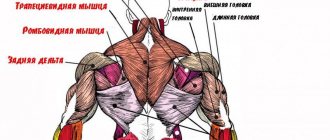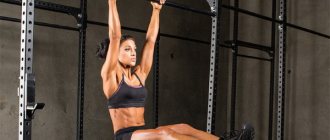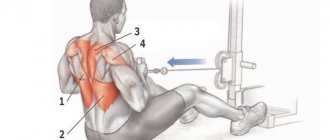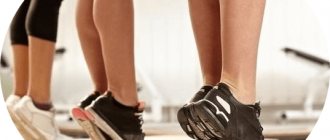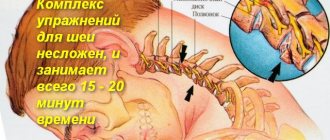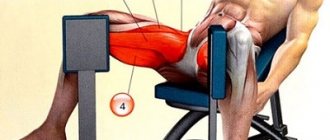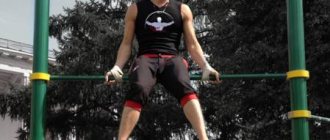At some point, every bodybuilder realizes that one part of his body is more pumped up than another. As a rule, your back suffers the most, so don't forget about it.
At some point, every bodybuilder realizes that one part of his body is more pumped up than another. As a result, there is an external imbalance of proportions. As a rule, the back suffers the most, because... Beginning athletes pay much less attention to it. And this is wrong, because all muscle groups must be developed in parallel; a large gap should not be allowed between them.
If your back is weak, then no matter how hard you try to achieve an athletic physique, you will not succeed; only with strong muscles you can lift heavy weights. Again, it will be much easier for you to exercise on exercise machines and adhere to the correct technique for doing the exercises.
First, let's look at a basic program for general back development on the horizontal bar.
What muscle groups work when doing pull-ups on a horizontal bar?
It would seem that only the arms do all the work, but the main force is accumulated in the back.
What muscles are pumped on the horizontal bar? The latissimus and trapezius muscles of the back, which are responsible for the work of the shoulders, receive the greatest load. Trapezoids are located in the middle of the upper back and have a trapezoidal shape.
The latissimus dorsi and trapezius dorsi muscles are connected to the biceps, deltoids, pectoralis major and minor muscles. In terms of surface area, the latissimus is the largest muscle in the human body.
The trapezius muscles are also of impressive size, hence the answer to the question: Pull-ups work most of a person’s muscle mass. These muscles are a powerful bundle of energy, so it is worth developing their strength to improve the health of your back and pump it up, making it thicker and wider.
Strength complex to strengthen the lumbar muscles
The strength complex allows you not only to protect your own spine from unwanted injuries, but also to give your back a beautiful relief. It also promotes the development of beautiful posture. What is this complex?
- To begin, lie comfortably on the mat with your stomach.
- Then stretch your arms and legs, arch your back, and lift your arms and legs about 30 degrees.
- Stay in this position for at least 5-10 seconds and return to the starting position.
- Repeat 10-15 times a day.
Basic exercises for strengthening the back cannot be imagined without the well-known pump. It is done as follows:
How to pump up the latissimus dorsi muscles on the horizontal bar
Pull-ups are the best exercise for adding width to your back. With the right technique, you can significantly increase this muscle group. Below I will tell you how to start “wings” while practicing on the bar.
For those unfamiliar, the “wings” are large, flat, triangular muscles located on the back of the torso, on the sides of the spine from the shoulders to the lower back.
The best results come from wide-grip pull-ups.
The goal of the program : to pump up a wide back.
You can perform this exercise in 2 ways:
- Chest Pull-Ups
With this embodiment, the grip is as wide as possible; you need to reach for the bar with your chest, so you can increase the width and thickness of your back. Throughout the entire approach, each repetition should be smooth and without jerking. It's quality that matters here, not quantity.
- Head pull-ups
This version of the exercise is also done with a wide grip, but is more designed to work on the width of the back muscles, but is not suitable for everyone. When pulling up, you need to put your head behind the bar and touch it with your shoulders. If you have poor shoulder mobility, it is best not to use this option.
Basic rules for performing exercises on the horizontal bar:
- Pull the body with muscle strength, without inertia;
- Don't swing;
- Rise without jerking, lower smoothly without throwing your body down;
- Breathe correctly: exhale for effort, inhale for relaxation (do not hold your breath under any circumstances);
- Be sure to warm up before training;
- Regular training (2-3 per week), alternating with rest. Rest is the basis of recovery, recovery is the growth of your muscle mass;
- The optimal number of repetitions and approaches (sets). You set the number of repetitions and approaches for yourself individually, depending on your capabilities. To achieve growth, you need to do 3-4 approaches, each with 8-12 repetitions;
- Take rest between approaches, it is recommended to rest for 1.5-2 minutes.
Please note: Over time, your own body weight will be insufficient to stimulate muscle anabolism (muscle growth). You won't be able to create enough stress, then you can increase the number of repetitions or reduce the rest time between sets.
When your growth progress stops altogether or it becomes very easy for you, it’s time to start using additional weight that you can hang on your belt.
What exercises are good for your back?
There are many exercises aimed at strengthening the lower back, but among them there are also those that can cause harm instead of benefit!
In general, exercises can be divided into static (the muscle does not contract) and dynamic (it contracts). When training your back, give preference to statics.
Why is that? Our spine is well adapted to axial load, but only in its natural position. When lumbar lordosis (bend in the lower back) changes, the intervertebral discs are compressed unevenly, which can lead to their damage. Therefore, hyperextension with a bend in the lower back or other similar exercises should be excluded!
Now about the useful stuff - about statics! The main task here is to keep the lower back motionless. To develop the correct position of the spine, it is best to use a stick or body bar.
With the correct body position, the stick touches three points: the tailbone, the space between the shoulder blades and the back of the head. In this case, the knuckles of the lower hand should touch the lower back.
The stick technique can be used in many back exercises:
- Bend forward.
- Deadlift on straight legs.
- Deadlift.
- Hyperextension.
Once you understand and feel the correct position of the spine, you can start training without a stick.
Strength exercises alone are not enough to keep your back healthy. Use complexes of therapeutic exercises, even if your back does not bother you. They will help stretch your muscles and improve their tone!
Separately, we can highlight aerobic exercises - running, swimming, walking at a moderate pace, which improve blood circulation and nutrition of the intervertebral discs. Swimming completely removes most of the stress from the spine. What is important after heavy strength training.
Increase the strength of your back muscles!
Pull-ups have no equal in effectiveness and versatility among other exercises for the back muscles.
Pull-ups pump up your back like no other exercise, but a few sets won't build up an impressive wing. Below you will find a truly effective workout plan for pumping up your back.
Each muscle group has its own standard exercise, performing which this group swings faster. Any training program includes such standard exercises for different muscle groups. When it comes to back training, pull-ups have no equal in terms of effectiveness and versatility.
Raising your body from a hanging position sounds simple, but is not practical for most people. Many basic exercises, such as squats or various forms of push-ups, for example, are found quite often in everyday life, which cannot be said about pull-ups. Even the most pumped-up weightlifters would rather lie under the barbell than climb onto the horizontal bar, because the latter is incredibly difficult to do. Don't be scared right away if you don't succeed the first time. In any case, you have to start somewhere.
To pump up your back and avoid back problems, which are common lately, start doing pull-ups on the horizontal bar right now for preventive purposes and to strengthen your back. This exercise can easily be included in any training plan.
Sports exercises and tips in pictures and videos
Anyone who wants to have a beautiful and inflated lower back should know how to pump up their lower back at home or on a horizontal bar.
Because without exercise you won’t be able to achieve the best results. Lower back exercises are actually easy, but require regular exercise and proper nutrition. All you need to start with is motivation, decide what results and why you want to achieve. This energy and desire will always help you when you want to quit training halfway towards your goal.
Set goals and achieve them, but remember about health and proper diet and exercise.
Since overload also harms human health, you need to decide on the measure that you will observe, gradually increasing the load with the arrival of new strength, endurance and energy. Find out: how to pump up your lower back muscles at home.
Of course, you don't need to go to the gym to pump up your lower back, although it's much faster there. But even at home there is a whole range of exercises necessary for the lower back that will effectively and safely allow you to achieve results.
At home, it is advisable to pump your lower back every other day to give it some rest and not overload it, so as not to harm your health.
Work your lower back slowly for the first time, gradually increasing the load.
Make a plan and schedule for training every other day at the same time, following your diet and exercise routine. And also, knowing immediately what exercises you will perform and in what sequence.
Of course, to pump up your lower back on the horizontal bar, you can install it at home. But if this is not possible, then you can easily find or make a horizontal bar on the street.
Exercises for the lower back on the horizontal bar do not require heavy loads; they simply do not need to be done for health reasons.
First you need to develop the correct technique, and only then increase the load.
The problem is that often incorrect exercises lead to various injuries and poor health. Therefore, watch how you need to properly pump your lower back muscles and follow this example until you get used to training this way and develop a certain training technique. Find out what there are: exercises for the lower back.
Bend the torso forward. Take a lightly weighted barbell or a simple stick and bend your torso, keeping your back straight. Lower and rise slowly, fixing the load. Don't lift too much weight at first.
Squats with dumbbells. You can also do simple squats, but using dumbbells. Try to do squats not quickly as usual, but slowly, trying to put the load not on your legs, but on your spine.
Pull-ups on the bar. You need to pull yourself up not as usual, with your chin touching the bar, but on the contrary, pulling up the back of your neck and back. This exercise is the most effective for pumping up your lower back on the horizontal bar or at home. Find out what it is: gymnastics for the lower back.
Don’t come up with complicated exercises for your lower back, especially with heavy weights. Start developing your technique.
Do small loads at first, gradually increasing them.
Remember to eat 3 times a day, exercise 2 hours after meals. Drink more water and try to eat all the healthiest foods, fish - 2 times a week, meat - every other day.
Always motivate yourself before training and set specific goals.
Every day our back receives a lot of stress, and therefore is subject to various sprains and injuries. To avoid this, you need to do simple exercises to strengthen your lower back, which you can do even at home. What kind of exercises are these?
In simple terms, the entire workout can be divided into two main categories: strength and stretching. The training program is based on bodyweight training, without weights. Let's start in order.
Grip options
It's mostly up to you to decide how to grip the bar with your hands. Purely intuitively, people choose the straight grip that is most comfortable for them. It is worth changing the types of grip from time to time, which will allow the same muscles to work differently.
A narrower reverse grip, with the palms facing toward the shoulders, is used to work the arm muscles, especially the biceps. To pump up the latissimus dorsi muscles, use a wider, straight grip with your palms facing outward, this will allow you to pump up your broad back as quickly as possible. You can change and alternate grip types right during training, which is very useful so as not to overload only one muscle group.
The best exercises to strengthen your back in the gym
The fitness room provides more training opportunities for both beginners and professionals.
All those who have just come to the gym need to first strengthen their weak back muscles and learn the correct technique in simple exercises. Therefore, I advise you to start with hyperextension. And only after you understand which muscles work and learn to bend your torso at the hip joint, and not at the lower back, will you be able to move on to more complex movements.
In the initial stages, one exercise for the back will be quite enough.
A pro differs from a beginner not only in muscle mass, but also in the level of technique.
Hyperextensions are also suitable for a professional, but with the use of additional weights. Use a plate or barbell as weight. For example, weightlifters perform an exercise with a barbell on their shoulders, but with minimal weight. This trick helps strengthen not only the lower back, but also the shoulder girdle.
You can’t ignore the most popular exercise among athletes – the deadlift. Despite the fact that many consider this exercise to be harmful, with the correct technique it will bring more benefit than harm. But it should only be used after achieving good training experience!
You can learn about the correct deadlift technique from the video:
Can a beginner or overweight person do pull-ups?
I first encountered a horizontal bar at the age of 15. It was 1994. My gym buddy and I went to his dad's garage for a back workout. He went to the horizontal bar and did 25 wide-grip pull-ups. I was impressed!
It's my turn. I jumped up, spread my arms wide on the bar, gathered my strength and... pulled myself up once. Impressive, right? My 5 sets of 1 rep each went completely unnoticed that day. However, instead of avoiding the horizontal bar, I decided to master the basics of this difficult exercise for me on the horizontal bar for the back, and later began to hone my skills.
To do many pull-ups in one approach, you need to have good strength and endurance. But the number of repetitions performed is not the most important thing in this exercise.
The main thing is to set realistic goals and achievable goals, especially in the initial stages, because lifting your own body weight is not so easy.
Beginners should try jumping pull-ups to begin with, because the working muscles are included in the training process precisely during the negative phase of the back exercise on the horizontal bar, namely lowering rather than lifting the body up. It is important not just to go down sharply, but to perform the negative phase slowly and with maximum muscle tension, which will also reduce the risk of injury.
In my opinion, absolutely anyone with the right motivation and the necessary practice can catch up. Only practice and dedication will lead you to perfection!
If you can’t do it even once or just once, under no circumstances remove pull-ups from your training plan. Approaches with 1 repetition will eventually turn into 2 repetitions, and where 2 and three are not far away. You yourself will not notice how already 10 repetitions in one approach will seem like baby talk to you. My best result in one set was 37 wide-grip pull-ups. I can also do two pull-ups with an additional weight of 45 kg and 20 pull-ups with an additional weight of 11 kg. Inflating does not happen immediately. It took years of hard work to get such beautiful and powerful back muscles, but believe me, it's worth it.
Why strengthen your lower back
Let me give you a simple example. You probably know what nunchucks look like, if not, watch the films with Bruce Lee again. So, two hard sticks are the lower and upper parts of the body. They have a lot of bones and muscles, so they can withstand all kinds of external load well. What is in the middle that connects the top and bottom? One single lumbar spine!
Although it is strengthened by muscles, it is still very vulnerable. Particularly due to its high mobility. In addition, the lower back is involved in almost all types of household activities and problems with it can cause considerable discomfort!
If you already feel any back pain from time to time, this is a reason to be wary! What can cause them?
- A nagging or aching pain can be a result of a muscle strain and is very common. For it to appear, sometimes it is enough to lift something heavy while bending your back.
- Acute pain is an indicator of more serious injuries. If we consider soft tissues, the problem may be caused by microdamage or ruptures of muscle fibers. If you look at the bone structure, the cause of discomfort lies in damage to the intervertebral discs (protrusion, hernia, lumbosacral radiculitis).
- Diseases not related to the musculoskeletal system. For example, kidney disease. Their insidiousness is that the symptom can be pain, as in muscle damage or osteochondrosis.
Training program for pumping your back on the horizontal bar
This training plan is aimed at working the back muscles from all sides. The training will take approximately an hour. It includes pull-ups with a variety of grip variations and hand positions. Personally, I always aim to perform about 200 repetitions with minimal rest breaks. I usually rest for about 30-60 seconds.
For beginners, I recommend starting with a pull-up machine, rubber bands to help, or just placing a bench under your feet. There is nothing to be ashamed of - everyone has their own start.
And yet, how to pump up your back on the horizontal bar? Here's my personal training regimen.
| Exercises | How to do |
4-5 sets of 25, 17, 15, 12, 12 reps | |
4-5 sets of 25, 17, 15, 12, 12 reps | |
4-5 sets of 25, 17, 15, 12, 12 reps | |
4-5 sets of 25, 17, 15, 12, 12 reps |
Table of training on the horizontal bar in the form of a picture for downloading
In the empty spaces below, you record the number of reps performed per set and the additional weight, if any. If you performed 10 repetitions with a weight of 45 kg, then write it down as “4 X 10”.
Types of pull-ups
By grip width
- Narrow : 10–15 cm between arms. The muscles of the arms (biceps) and deltoids work maximally.
- Medium : Place your hands slightly wider than your shoulders. The latissimus dorsi muscles are trained, and the forearms and deltoids are used at the top point.
- Wide : Arms are wider than shoulder-width apart. The upper part of the latissimus muscles and shoulders are worked out.
Read the article “What muscles work during wide pull-ups”
By type of grip
- Upper (pronated, normal): fingers pointing away from you. An easy-to-use grip helps work the entire upper shoulder girdle and back.
- Reverse (supinated): palms facing the face. The biceps bear the main load; the latissimus muscles are trained to a lesser extent.
- Parallel (neutral): palms facing each other. This grip is the safest for your joints. Pull-ups are performed on a special horizontal bar with handles located parallel to each other at a short distance. The lower latissimus muscles receive the lion's share of the load. The biceps, brachial muscles (brachialis), and chest muscles are also improved.
- Combined (opposite): palms of the hands are directed in different directions. The lower and middle back works, and the biceps and shoulder muscles are additionally trained. You can hold along the bar so that your hands are behind each other on the same line (military pull-ups). Or you can perform the exercise while in a standard position relative to the horizontal bar and holding it with one hand with a direct grip and the other with a reverse grip.
By finger position
- Open (monkey): All fingers are on one side of the bar. Has virtually no effect on the benefits of pull-ups. There is a risk of slipping, so it is more suitable for athletes with experience.
- Closed (titanium): The thumb is on the opposite side of the other fingers. Compared to open, it allows for better stretching of the latissimus muscles. The grip is less dangerous and recommended for beginners.
Upon touching the crossbar
- Standard : to the chest or to the chin. The latissimus and almost all the muscles of the upper back, arms and pectoral muscles are trained.
- Behind the head : the bar touches the neck. The upper back and trapezius are worked.
- “Dead” pull-ups : until your head touches the crossbar with a pause at the top point. This is an excellent back muscle pump for advanced athletes. The exercise is performed slowly and under control to avoid hitting your head on the horizontal bar.
By speed
- “Clean” pull-ups: a leisurely movement up and down.
- Explosive:
- quick pull-ups with slow lowering (to increase muscle mass);
- slow pull-up with quick lowering (to increase strength).
By technique
- On one hand with a direct or reverse grip: the free hand can be placed on the forearm of the first hand and placed behind the back.
- Half Moon : performed with a wide grip with the body shifted to one hand until the chin touches the hand.
- Hand-swithes : pull-ups with a clap at the top.
- Flip hand grip : at the top point the grip alternates from forward to reverse.
- “Gironde” : an exercise for the latissimus muscles is performed with a bend in the back and access to the crossbar of the middle part of the chest.
- Kipping, butterfly : during the descent, the body goes down in an arc and the load on the arms is reduced due to the swaying of the torso - swinging the legs with arching of the lower back.
The most popular among athletes is the classic straight grip with an average distance between the hands. The position is anatomically not as comfortable as with a reverse grip, but the back, shoulders, and triceps work to a greater extent and the biceps are practically not involved. “Advanced” athletes prefer to do pull-ups with weights: they put on a weightlifting belt and tie a dumbbell or barbell disc to it.
A standard pull-up can be safely included at the beginning of a back training complex:
- Pull-ups: 4 sets of 6–12 reps.
- Incline dumbbell pullovers or bent over barbell rows: 4 sets of 8-12 reps.
- Bent-over one-arm dumbbell rows: 4 sets of 12–15 reps.
Pull-ups on the horizontal bar are a complex multi-joint exercise in which the upper shoulder girdle is subjected to enormous load. Graviton will help beginners master the exercise. But don’t get carried away with the simulator - periodically try to perform the classic version of the treasured exercise.
Remember: you cannot learn to do pull-ups by doing only lat pull-downs or constantly placing a bench under your feet!
Benefits of the horizontal bar for the spine
Physiotherapy exercises for diseases of the spine often include exercises on the horizontal bar as part of a set of exercises.
Hanging and other elements of exercises on the horizontal bar suggest an improvement in the condition of the spine and bring tangible benefits to the spinal column:
- strengthen the muscular corset of the spine;
- help improve posture;
- normalize blood circulation in the vertebrae;
- relieve stress from intervertebral discs;
- eliminate current or systematically occurring back pain;
- restore normal blood supply to the spinal structures with blood vessels;
- improve back flexibility, stabilize the correct position of the vertebrae.
With systematic exercise on the horizontal bar, the flexibility of the back increases, pain is eliminated, and the mobility of the vertebrae is maximized. Daily stretching of the intervertebral spaces allows you to improve the general condition of the spine, strengthen the muscles and normalize the blood supply to the vertebrae.
In addition to treatment, exercises on the horizontal bar are useful for preventing diseases of the spinal column, especially if your lifestyle is predominantly sedentary. With inactivity, the risk of developing pathological processes is much higher, so systematic exercises on the horizontal bar can help maintain a healthy back.
